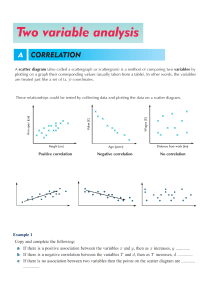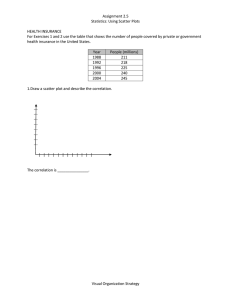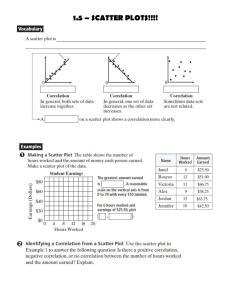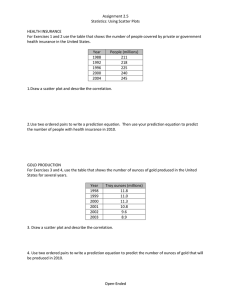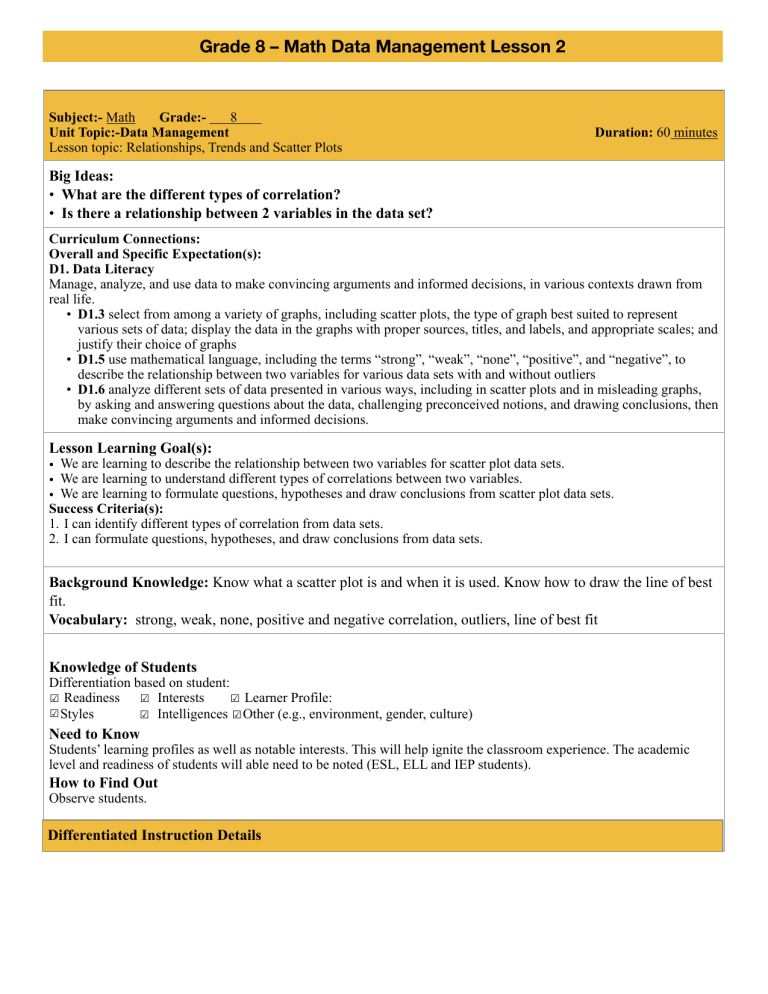
Grade 8 – Math Data Management Lesson 2 Subject:- Math Grade:8 Unit Topic:-Data Management Lesson topic: Relationships, Trends and Scatter Plots Duration: 60 minutes Big Ideas: • What are the different types of correlation? • Is there a relationship between 2 variables in the data set? Curriculum Connections: Overall and Specific Expectation(s): D1. Data Literacy Manage, analyze, and use data to make convincing arguments and informed decisions, in various contexts drawn from real life. • D1.3 select from among a variety of graphs, including scatter plots, the type of graph best suited to represent various sets of data; display the data in the graphs with proper sources, titles, and labels, and appropriate scales; and justify their choice of graphs • D1.5 use mathematical language, including the terms “strong”, “weak”, “none”, “positive”, and “negative”, to describe the relationship between two variables for various data sets with and without outliers • D1.6 analyze different sets of data presented in various ways, including in scatter plots and in misleading graphs, by asking and answering questions about the data, challenging preconceived notions, and drawing conclusions, then make convincing arguments and informed decisions. Lesson Learning Goal(s): • We are learning to describe the relationship between two variables for scatter plot data sets. • We are learning to understand different types of correlations between two variables. • We are learning to formulate questions, hypotheses and draw conclusions from scatter plot data sets. Success Criteria(s): 1. I can identify different types of correlation from data sets. 2. I can formulate questions, hypotheses, and draw conclusions from data sets. Background Knowledge: Know what a scatter plot is and when it is used. Know how to draw the line of best fit. Vocabulary: strong, weak, none, positive and negative correlation, outliers, line of best fit Knowledge of Students Differentiation based on student: ☑ Readiness ☑ Interests ☑ Learner Profile: ☑Styles ☑ Intelligences ☑Other (e.g., environment, gender, culture) Need to Know Students’ learning profiles as well as notable interests. This will help ignite the classroom experience. The academic level and readiness of students will able need to be noted (ESL, ELL and IEP students). How to Find Out Observe students. Differentiated Instruction Details Differentiated Instruction Response ☑Learning materials (content): Learn content from videos and digital media, Hear instructions orally, Provide lesson outline/PPT, Use visual organizers, Written list of instructions ☑Ways of learning (process): A variety of instructional strategies have been used to appeal to various learning styles, levels, and interests: - use of technological media (Comic strips, video clips, PowerPoint slides) - individual, pair, and whole-class activities ☑ Ways of demonstrating learning (product): Oral response, use a word processor to type notes or give responses in class ☑ Learning environment: Seating arrangements considered Accommodations and Special Needs: - Use of technology, visuals and auditory aids, group work and collaboration, note taking assistance - Verbal and written components to the lesson allow for students with different learning preferences - individual, pair, and whole-class activities Materials & Resources Materials • Markers, White Board, Laptop, Projector Lesson material • Lesson 6.9 Scatterplots Worksheet • Mean, Median and Mode (MMM)_ Scatter Plot_Review ppt. Agenda 1. Quiz on Monday 2. Scatterplots worksheet Textbook and Resources https://www.dcp.edu.gov.on.ca/en/curriculum/elementary-mathematics/grades/g8-math/strand-d/d1 Lesson Sequence Minds on (20 mins) Individual, in pairs and whole-group => Minds on Activity • Minds on: 1001 Pennies (Mr. Chin will teach Minds on) - there are 1001 pennies lined up on a table. I come along and replace every second coin with a nickel. Then I replace every third coin with a dime. Finally, I replace every fourth coin with a quarter. How much money is on the table? - $99.19 Assessment Opportunities A as L: Group work Class discussion • Mean, Median and Mode Review - Teacher will review mean, median and mode to prepare students for the upcoming quiz on Monday. (refer to MMM Review ppt) Action Individuals => lesson (30 mins) • Scatterplots (p. 94) - Ask students to individually read the example given in page 94 and in-pairs, discuss the questions below. Teacher will debrief with students from time to time. • What does the scatter plot show? • How do you draw the line of best fit? • What does the line of best fit tell you? - Students will answer questions on the bottom of p. 94 A as L & A for L: Class discussion • Scatterplots (p. 95) - Students will learn about positive and negative correlations - A positive correlation = line of best fit runs from the lower left to the upper right - A negative correlation = line of best fit runs from the upper left to the lower right - There could be no correlation. - Students will learn about Strong vs. Weak relationships between the x and y variables • When data points form close to a line, there is a strong relationship between the variables (x and y). • The scatter plot of a weak relationship between two variables shows points that are more spread out than those showing a strong relationship. • Teacher will show different plots (refer to Scatterplot ppt) and students will be asked to identify each plots as either strong +, strong -, weak +, weak correlation. Consolidation • Individuals => Exit activity A for L: and - Students will complete “Is there a relationship here?” Worksheet. Class discussion Connection - When formulating hypothesis, use the statement, “As (variable 1) inc/dec, (10 mins) (variable 2) dec/inc. - Ex from p. 94 - As weekly practice minutes increase, the number of runs scored increases. - Remind students to label (x, y and title) when creating a scatter plot. - Teacher will debrief with students. Reflection/Success criteria:

